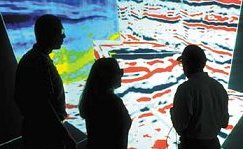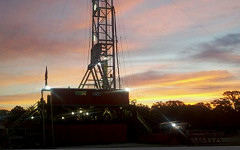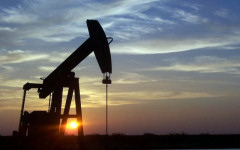Oil On My Shoes – The Original Petroleum Geology Site!
New Page – Fracking and Earthquakes in Oklahoma

What Does a Petroleum Geologist Do? Five Things!
Step 1: The Petroleum Geologist Prospects

Petroleum geologists are scientists that work to discover new oil and gas deposits. Petroleum geology is a “science of sciences.” The geologist puts skills in geology, physics, chemistry, biology, and other fields to the practical task of locating energy sources.
Prospecting is the work the petroleum geologist does to locate a place to drill a test hole, which hopefully can be turned into a producing oil or gas well!
For some reason, petroleum geologists are often depicted on television and movies standing in knee-deep mud. However, petroleum geology is a white-collar job. Almost all petroleum geology work is done in an office, where the geologist has access to a huge amount of data. These include electric logs, core records, drilling records, scout tickets, and production data. Geologists use the data to construct maps, stratigraphic and structural cross-sections, and databases. These sources help them locate the best places to drill their test holes.
Occasionally the petroleum geologist will visit a drilling site, but this is a very small part of the work. Travel to a drilling site is usually regarded as a good chance to get out of the office for a couple of days. This normally happens at the very end of the drilling process, when the hole is logged. Plus, the geologist wants to be there to see first-hand if his proposed location is successful!
The geologist will first construct many contour maps to help locate the prospect. He will make many cross-sections and run numerous computer simulations that help him select the next location to drill. He is always thinking about the next drilling location, or prospect !
He will want to know what type of trap he is dealing with, and the composition of the sedimentary rocks he will be drilling through. He needs to estimate the porosity of his prospective pay zone. He wants to know if dangerous high pressures can be expected in the new hole. If seismic data is involved in the new test, he will consult with the geophysicist and get his opinion of the prospect.
In certain areas, it will help to use biostratigraphy to help pinpoint the location.
The petroleum geologist is always interested in anything that happens in his area, particularly information on new discoveries by other companies! If he sees a promising new area, he will recommend to the land department that an attempt be made to lease the land. If an acquisition is possible, the leased acreage will be available for drilling later when the prospect is further developed.
When the geologist has finally found the best place, he will spot or locate the well using the land survey system most appropriate to the area. He spends much time cross-checking to ensure nothing has been missed. He wants to make sure he is not surprised by any of the following awful things:
- Discovering the selected location was already drilled by another company 40 years ago, records were lost, and the hole was dry.
- Discovering that his company has no legal right to drill on the location (lease problems)
- Unexpected faults or other geologic problems that crop up during drilling and ruin the prospect
- Discovering that the hole is being drilled in the wrong place after drilling begins (a very bad thing that has actually happened more than once!). In one instance I was aware of, the hole was drilled on the wrong person’s property, an entire mile away from the proposed location. The internal cover-up was unbelievable.
Step 2: The Petroleum Geologist Packages The Deal

Once the new location is defined, and the geologist is satisfied the prospect is a good one, the work is just beginning. He has a large amount of rough data available in the form of work maps and cross-sections that he used to satisfy himself of the feasibility. Now, he must condense this large data mass into a set of presentation materials that can be shown and explained to non-geologists.
To package the deal, he will prepare sets of simplified maps and stratigraphic cross-sections, highly-colored and attractive to the eye. He may use Powerpoint, or similar presentation software. Creativity, design sense, and art skills are important during this phase. He needs to anticipate all possible questions, and be prepared to answer each one of them. He must be very sure of himself and his facts before he moves to the next step.
Step 3: The Petroleum Geologist Sells the Deal

Now the geologist must step into a role that is often uncomfortable for him…selling his prospect. Geologists are scientists, with scientific backgrounds and schooling. They are used to talking to other scientists. But now the geologist must temporarily become a salesman in order to convince people who are not geology experts of the value of the prospect. These people may include managers, bankers, engineers, and oil and gas investors.
Of course, the geologist wants to see his prospect drilled. He will use all of his ability to present it in the best light. But there is a lot of room for interpretation with any prospect (that’s what makes it fun). There is a lot of art in any map, even scientific ones. But he will take great pains to ensure all his data is presented accurately and concisely. He is bound by his own integrity, the integrity of his professional group, and the integrity of his profession.
He is looking to convince his clients that
- the prospect is worth drilling,
- investors will get a fair return for their money
- the provided financing will be wisely spent
Even an inexpensive test hole can cost a couple of million dollars, and some exploration tests may run into many tens of millions! So the geologist wants to be very sure of his facts. All his clients must believe the proposed well has a reasonable chance of being successful.
The geologist will meet with the landman (females in the business are also called landmen), who will ensure the company has the legal right to drill in the chosen spot. He will consult with the engineer, who will estimate the exact cost of drilling and completing the hole. Marketing personnel will ensure the company has a market (buyer) for the oil, or a pipeline for the gas. Managers, responsible for ensuring the company’s drilling budget is spent wisely, will also approve the test. If outside financing will be used (not normal for large companies), the geologist will explain the prospect to technical representatives of the bank or other individuals or partnerships that put up the money.
When he’s done, the geologist will have sold his prospect to anywhere from a few to several dozen people.
Step 4: The Petroleum Geologist Monitors the Drilling of the Test

Next comes the part that every petroleum geologist enjoys the most! Drilling the hole! It has now been several months since the geologist started working on his prospect. Now the land owners have been paid for the leaes, permits acquired, and money allocated. Roads and the drilling location have been built, and pipe and supplies have been ordered. Also, the energy company has engaged a drilling contractor who owns and operates the drilling rig.
The drilling contractor will drill the hole in the exact manner specified by the company. The contractor will have some leeway to select the type of drill bits to be used, hire a drilling crew, and make many other decisions concerning the actual drilling. Virtually all holes are drilled by contractors.
Drilling a hole is a very complex procedure involving many people and many critical steps. Nearly everything must go right. Dangerous machinery, bad weather, and continuous mechanical failures are faced daily. The drilling rig never shuts down. The work goes on for weeks to months, twenty-four hours a day. It is a vigorous, nonstop operation. A slip-up at any point can ruin the very expensive hole, send a fortune down the tubes, get people killed, or all of the above.
The geologist will closely monitor all aspects of the drilling as it takes place. He will select an electric-logging company, and specify the proper wireline logging tools to evaluate the hole. He will hire a mud logging contractor to sit the well day and night. The mud logger will study the well cuttings, report shows of oil and gas, and act as the geologists’ spy on the drilling location. The geologist will monitor the formation tops as they are encountered, and discuss the progress of the drilling with the investors. The geologist will decide where and when to take cores or drill-stem tests. Finally, after the hole is logged with electric logs, the geologist will examine the electric logs and recommend that the hole be either completed or plugged.
Step 5: The Petroleum Geologist Works With The Engineer to Complete the Well

At last the hole is drilled! At this time, a decision must quickly be made to attempt a completion and make the hole a well, or plug the dry hole. Completion costs are extremely high (often as much or more than the drilling costs), so it must be believed the expensive completion will be worth the money. No one wants to throw good money after bad. Justifying a completion can be a grueling process. This nerve-wracking procedure always takes place in the middle of the night!
The job of actually doing the completion work on the hole is mainly in the hands of the petroleum engineer. The geologist will advise the engineer on various topics before the completion begins.
The geologist is often the person most familiar with the technical practices of other area oil companies. The geologist may know about some competitors with better ideas. Like the case of the small company Mitchell Energy, who cracked the code of shale gas production back in the 1990’s.
To start, the geologist will give the engineer a list of formation tops, and tell the engineer exactly which zones and depths should be tested. He might suggest a certain style or method of perforation, or offer advice on cementing techniques. He will relay whatever information he has to the petroleum engineer, who will usually be thankful for the help!
Working as a team, the geologist and petroleum engineer will get the new well completed, and put it to work providing energy for all of us!
